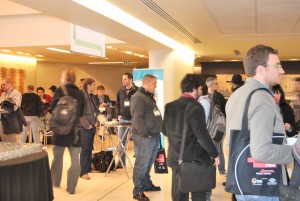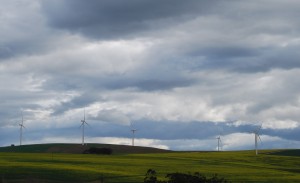CHAPTER < TWELVE - FINDING SUSTAINABLE SOLUTIONS CONTD.
 The next great energy revolution to leave its mark on the people and ecology of planet Earth was nuclear power. Once the great energy hope of the future, at the height of its popularity as an energy source the nuclear industry grew by more than 700 per cent. But over previous decades it has slowed down, until it has tapered off to an increase of less than five per cent.
The next great energy revolution to leave its mark on the people and ecology of planet Earth was nuclear power. Once the great energy hope of the future, at the height of its popularity as an energy source the nuclear industry grew by more than 700 per cent. But over previous decades it has slowed down, until it has tapered off to an increase of less than five per cent.
This small growth factor is expected to decline even further in the next few years, with the principle reason behind nuclear power’s decline in favour being negative public sentiment whipped up by major nuclear accidents such as Three Mile Island and Chernobyl, which posed considerable health threats for millions of people around the globe, as well as contributing to an alarming rise in levels of background radiation. The transport and storage of radioactive wastes, which in the case of some substances take millions of years to lose radioactivity, have also become major problems globally. However its lack of competitiveness with other newer forms of power generation, and the prohibitive cost of building and maintaining reactors are the most significant reasons for declining nuclear generating capacity.
Despite providing 16 per cent of global electricity generation in 2002, in many quarters nuclear power is now no longer considered the “wunderkind” of power generation. Even with new technologies such as the Pebble Bed Modular Reactor, which is a new type of high temperature gas nuclear power plant that has built-in safety characteristics requiring no human intervention, public opinion has turned against nuclear power and for many people who grew up fearing a nuclear meltdown, acting out safety drills under school desks at lunchtime in preparation for a possible nuclear holocaust, it has become an energy pariah. So where to from here?
New Energy Initiatives
 From the first to eleventh December 1997 representatives from more than 160 countries met in Kyoto, Japan, to negotiate binding targets on greenhouse emissions for participating nations. This meeting of more than 10 000 delegates marked the beginning of the adoption of the principles of the Kyoto Protocol.
From the first to eleventh December 1997 representatives from more than 160 countries met in Kyoto, Japan, to negotiate binding targets on greenhouse emissions for participating nations. This meeting of more than 10 000 delegates marked the beginning of the adoption of the principles of the Kyoto Protocol.
It was the beginning of a formal attempt to limit concentrations of the greenhouse gasses: carbon dioxide, methane, nitrous oxide, hydrofluorocarbons, perfluorocarbons and sulphur hexafluoride which, when found in high enough concentrations in the atmosphere, contribute to changes in the Earth’s climate. As such it marked a significant restructuring of thinking; an important step forward for the energy industry as a whole.
However, ecologically progressive thinking in the electricity supply technology field is by no means a recent phenomenon. Along with the adoption of various ways of reducing energy-related carbon emissions such as adopting more energy-efficient equipment, implementing solutions such as smokestack “scrubbers” and restricting the use of carbon-intensive fuels such as crude oil, gas and coal; energy utilities have been flirting with other sources of energy as viable means of generating electricity for some time now.
With the environmental dangers of electricity generated by the combustion of fossil fuels having become evident and the popularity of nuclear power having declined, we need a major sustainable energy initiative to turn to that will ensure the safety of both humanity and the environment on which we depend for our existence.
In a bid to solve this pressing problem, researchers around the world have experimented and continue to experiment with a host of different possibilities for generating energy, each having its own inherent advantages and disadvantages. Up to now no one particular electricity supply technology has been developed as the next definitive energy trend and a mix of electricity generating technologies are poised to take us further into the 21st Century, depending on each geographical and political region’s situation and needs. These electricity supply options include renewable energy sources such as solar, wind and wave power, gas-and coal-fired power, hydro power, even biomass (vegetation) burning and geothermal energy.
At the moment these alternatives to fossil fuel generated electricity and nuclear power are still only in an infancy stage, providing a relatively small proportion of world energy. However before electricity emerged as a viable alternative to steam-power, it also went through an initial faltering phase of development; until Edison’s first central power generating station began operating in Pearl Street, New York, in September 1882, lighting some 3000 lamps in the area, which signalled the beginning of the electricity revolution.
With the restructuring of thinking and the experimentation of new possibilities that have been taking place, our energy tomorrow looks promising. As with the Green Revolution and the Blue Revolution, the Energy Revolution has progressed from one technological innovation to the next; rejecting some past inventions when their usefulness had declined and other more up-to-date breakthrough solutions had been found, and embracing other new initiatives as they became available. As the raw materials for an energy generating solution became scarce we have been able to substitute others, drawing from the resources of the natural world around us. In this way we have continued to meet the essential energy needs of most of the Earth’s people.
 A sustainable tomorrow is our most important goal for the future. Being well aware of the urgency behind finding equitable solutions for global food, freshwater and energy requirements that will take us well into the 21st Century; our scientists, engineers, geologists, ecologists, economists, farmers and many others are pitting their know-how against the need to stretch the dwindling resources of the planet as far as they are able to go. For the people of the world it is a race against time. How we continue to approach the balance between our own needs and the dynamics of planet Earth will determine our future. In our favour is a track record of ingenuity and daring resourcefulness. I do not believe that these qualities will fail us at the eleventh hour. As they have done before, I believe that they will take us into a bright new day…
A sustainable tomorrow is our most important goal for the future. Being well aware of the urgency behind finding equitable solutions for global food, freshwater and energy requirements that will take us well into the 21st Century; our scientists, engineers, geologists, ecologists, economists, farmers and many others are pitting their know-how against the need to stretch the dwindling resources of the planet as far as they are able to go. For the people of the world it is a race against time. How we continue to approach the balance between our own needs and the dynamics of planet Earth will determine our future. In our favour is a track record of ingenuity and daring resourcefulness. I do not believe that these qualities will fail us at the eleventh hour. As they have done before, I believe that they will take us into a bright new day…